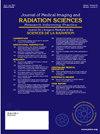Establishment of Institutional Diagnostic Reference Level for Computed Tomography Coronary Angiogram
IF 1.3
Q3 RADIOLOGY, NUCLEAR MEDICINE & MEDICAL IMAGING
Journal of Medical Imaging and Radiation Sciences
Pub Date : 2024-10-01
DOI:10.1016/j.jmir.2024.101535
引用次数: 0
Abstract
Introduction
Computed Tomography Coronary Angiogram (CTCA) can be routinely performed using prospective or high-pitch ECG gating, acting as valuable diagnostic imaging tool for cardiovascular disease. However, one of the concerns associated with CTCA is the ionizing radiation. Establishing an institutional diagnostic reference level (DRL) for CTCA in adults is a valuable initiative to optimize radiation dose and ensure patient safety. The aim of the study is to establish institutional diagnostic reference level in CTCA for adult 16 years old and above.
Methods
One-year CT dose data of 232 patients above 16 years old regarding CTCA from 01 Jan 2022 to 31 Dec 2022 were retrospectively collected for analysis from existing dose-tracking software. CTCA comprises two parts of scans: calcium score and angiogram. Calcium score was performed with high-pitch ECG gated protocol while angiogram was performed with either prospective sequence protocol or high-pitch protocol based on the patient's heart rate. The data extracted included information on scan protocols, patient demographics and radiation dose parameters. Excel version 2016 was used to calculate the mean, 75th percentile, and 90th percentile of CT dose index (CTDIvol) and dose length product (DLP) distribution according to calcium score, prospective ECG-gated and high-pitch scanning protocols.
Result
The institutional DRL for CTCA for our CT units were established as mean (50th percentile) of CTDIvol (mGy), DLP (mGy.cm) for CT calcium score exam, prospective ECG-gated exam and high-pitch ECG-gated exam. Calcium score exam: (1.35 mGy), (25.15mGy.cm) respectively; Prospective ECG-gated exam: (18.43mGy), (251.55mGy.cm) respectively; High-pitch ECG-gated exam: (2.98mGy), (58.9 mGy.cm) respectively.
Conclusion
The study indicates that CTCA using High-pitch ECG-gated protocol results in much lower radiation exposure compared to the prospective ECG-gated protocol. The reported matrix offers a variety of dose information for quality improvement activities.
确定计算机断层扫描冠状动脉造影的机构诊断参考水平
导言 计算机断层扫描冠状动脉血管造影术(CTCA)可通过前瞻性或高间距心电图门控进行常规检查,是诊断心血管疾病的重要成像工具。然而,与 CTCA 相关的一个问题是电离辐射。为成人 CTCA 建立机构诊断参考水平(DRL)是优化辐射剂量和确保患者安全的重要举措。该研究旨在为 16 岁及以上成人的 CTCA 建立机构诊断参考水平。方法通过现有的剂量追踪软件,回顾性地收集了 232 名 16 岁以上患者从 2022 年 1 月 1 日至 2022 年 12 月 31 日一年的 CTCA CT 剂量数据进行分析。CTCA 包括两部分扫描:钙化评分和血管造影。钙化评分采用高分贝心电图门控方案,而血管造影则根据患者的心率采用前瞻性序列方案或高分贝方案。提取的数据包括扫描方案、患者人口统计学和辐射剂量参数等信息。使用 Excel 2016 版计算 CT 剂量指数(CTDIvol)的平均值、第 75 个百分位数和第 90 个百分位数,以及根据钙评分、前瞻性心电图门控和高间距扫描方案计算的剂量长度乘积(DLP)分布。钙评分检查:分别为(1.35 mGy)、(25.15 mGy.cm);前瞻性心电图门控检查:分别为(18.43 mGy)、(251.55 mGy.cm);高分辨率心电图门控检查:分别为(2.98 mGy)、(58.9 mGy.cm)。报告的矩阵为质量改进活动提供了各种剂量信息。
本文章由计算机程序翻译,如有差异,请以英文原文为准。
求助全文
约1分钟内获得全文
求助全文
来源期刊

Journal of Medical Imaging and Radiation Sciences
RADIOLOGY, NUCLEAR MEDICINE & MEDICAL IMAGING-
CiteScore
2.30
自引率
11.10%
发文量
231
审稿时长
53 days
期刊介绍:
Journal of Medical Imaging and Radiation Sciences is the official peer-reviewed journal of the Canadian Association of Medical Radiation Technologists. This journal is published four times a year and is circulated to approximately 11,000 medical radiation technologists, libraries and radiology departments throughout Canada, the United States and overseas. The Journal publishes articles on recent research, new technology and techniques, professional practices, technologists viewpoints as well as relevant book reviews.
 求助内容:
求助内容: 应助结果提醒方式:
应助结果提醒方式:


